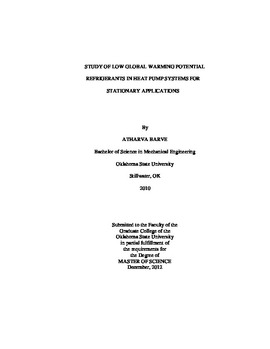| dc.contributor.advisor | Cremaschi, Lorenzo | |
| dc.contributor.author | Barve, Atharva | |
| dc.date.accessioned | 2014-04-17T19:51:57Z | |
| dc.date.available | 2014-04-17T19:51:57Z | |
| dc.date.issued | 2012-12-01 | |
| dc.identifier.uri | https://hdl.handle.net/11244/9893 | |
| dc.description.abstract | R410A is one of the major refrigerants used for air conditioning and heat pump systems in residential applications. It has zero ODP but its GWP is about 2,000. In China and Japan, refrigerant R32 (GWP = 675, zero ODP) has been proposed as possible replacement for R410A but this refrigerant is slightly flammable. HFO-1234yf is a refrigerant with low GWP (GWP = 4, zero ODP) that is currently being used in European car market as a possible replacement for R134a. This thesis focuses on an experimental comparison of the drop-in energy performance and capacity of two low GWP refrigerants in a R410A heat pump split system for ducted residential applications. The experiments were conducted in a large scale psychrometric chamber at Oklahoma State University and on a 5 ton heat pump unit that was commercially available. Refrigerant cycle temperatures and pressures, pressure drops in the heat exchangers, degree of superheat and liquid subcooling were measured to examine the pros and cons when R410A is replaced with R32 and with HFO-1234yf without any system modification. The tests were conducted for cooling and heating mode of the unit and the outdoor temperature was varied from 17 F to 115 F. Cooling tests at AHRI standard rating conditions were performed and the refrigerant charge was optimized. Two additional conditions were considered with high outdoor temperatures of 110 F and 115 F to analyze the behavior of the unit at extreme ambient and at off-design conditions. Some challenges related to refrigerant charge management that must be considered when switching operation mode of the heat pump unit from summer to winter seasons if R32 and HFO-1234yf are directly retrofitted in the unit. It was observed that the COP tends to be higher for the R32 and R1234yf as compared to R410A with some peculiar behavior at very high temperatures, in which R32 COP was lower than the one for R410A. The capacity for refrigerant HFO-1234yf was 40 to 50% lower and several challenges with the management of the charge and the TXV operation were observed. | |
| dc.format | application/pdf | |
| dc.language | en_US | |
| dc.publisher | Oklahoma State University | |
| dc.rights | Copyright is held by the author who has granted the Oklahoma State University Library the non-exclusive right to share this material in its institutional repository. Contact Digital Library Services at lib-dls@okstate.edu or 405-744-9161 for the permission policy on the use, reproduction or distribution of this material. | |
| dc.title | Study of Low Global Warming Potential Refrigerants in Heat Pump System for Residential Applications | |
| dc.type | text | |
| dc.contributor.committeeMember | Fisher, Daniel | |
| dc.contributor.committeeMember | Ghajar, Afshin | |
| osu.filename | Barve_okstate_0664M_12425.pdf | |
| osu.college | Engineering, Architecture, and Technology | |
| osu.accesstype | Open Access | |
| dc.description.department | Mechanical & Aerospace Engineering | |
| dc.type.genre | Thesis | |
| dc.subject.keywords | heat pump | |
| dc.subject.keywords | hfo-1234yf | |
| dc.subject.keywords | low gwp | |
| dc.subject.keywords | r32 | |
| dc.subject.keywords | refrigerants | |
